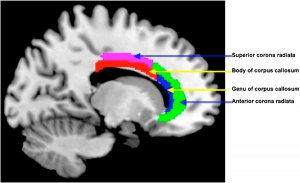 EUGENE, Ore. -- (Aug. 16, 2010) -- Just 11 hours of learning a meditation technique induces positive structural changes in brain connectivity by boosting efficiency in a part of the brain that helps a person regulate behavior in accordance with their goals, researchers report.
EUGENE, Ore. -- (Aug. 16, 2010) -- Just 11 hours of learning a meditation technique induces positive structural changes in brain connectivity by boosting efficiency in a part of the brain that helps a person regulate behavior in accordance with their goals, researchers report.
The technique -- integrative body-mind training (IBMT) -- has been the focus of intense scrutiny by a team of Chinese researchers led by Yi-Yuan Tang of Dalian University of Technology in collaboration with University of Oregon psychologist Michael I. Posner.
 IBMT was adapted from traditional Chinese medicine in the 1990s in China, where it is practiced by thousands of people. It is now being taught to undergraduates involved in research on the method at the University of Oregon.
IBMT was adapted from traditional Chinese medicine in the 1990s in China, where it is practiced by thousands of people. It is now being taught to undergraduates involved in research on the method at the University of Oregon.
The new research -- published online Aug. 16 ahead of regular publication in the Proceedings of the National Academy of Sciences -- involved 45 UO students (28 males and 17 females); 22 subjects received IBMT while 23 participants were in a control group that received the same amount of relaxation training. The experiments involved the use of brain-imaging equipment in the UO's Robert and Beverly Lewis Center for Neuroimaging. (The paper was published in the Aug. 31 issue of PNAS.)
 A type of magnetic resonance called diffusion tensor imaging allowed researchers to examine fibers connecting brain regions before and after training. The changes were strongest in connections involving the anterior cingulate, a brain area related to the ability to regulate emotions and behavior. The changes were observed only in those who practiced meditation and not in the control group. The changes in connectivity began after six hours of training and became clear by 11 hours of practice. The researchers said it is possible the changes resulted from a reorganization of white-matter tracts or by an increase of myelin that surrounds the connections.
A type of magnetic resonance called diffusion tensor imaging allowed researchers to examine fibers connecting brain regions before and after training. The changes were strongest in connections involving the anterior cingulate, a brain area related to the ability to regulate emotions and behavior. The changes were observed only in those who practiced meditation and not in the control group. The changes in connectivity began after six hours of training and became clear by 11 hours of practice. The researchers said it is possible the changes resulted from a reorganization of white-matter tracts or by an increase of myelin that surrounds the connections.
"The importance of our findings relates to the ability to make structural changes in a brain network related to self regulation," said Posner, who last fall received a National Medal of Science. "The pathway that has the largest change due to IBMT is one that previously was shown to relate to individual differences in the person's ability to regulate conflict."
In 2007 in PNAS, Tang, a visiting scholar at the UO, and Posner documented that doing IBMT for five days prior to a mental math test led to low levels of the stress hormone cortisol among Chinese students. The experimental group also showed lower levels of anxiety, depression, anger and fatigue than students in a relaxation control group.
In 2009 in PNAS, Tang and Chinese colleagues, with assistance from Posner and UO psychology professor Mary K. Rothbart, found that IBMT subjects in China had increased blood flow in the right anterior cingulate cortex after receiving training for 20 minutes a day over five days. Compared with the relaxation group, IBMT subjects also had lower heart rates and skin conductance responses, increased belly breathing amplitude and decreased chest respiration rates.
The latter findings suggested the possibility that additional training might trigger structural changes in the brain, leading to the new research, Tang and Posner said. The researchers currently are extending their evaluation to determine if longer exposure to IBMT will produce positive changes in the size of the anterior cingulate.
Deficits in activation of the anterior cingulate cortex have been associated with attention deficit disorder, dementia, depression, schizophrenia and many other disorders. "We believe this new finding is of interest to the fields of education, health and neuroscience, as well as for the general public," Tang said.
In their conclusion, the researchers wrote that the new findings suggest a use of IBMT as a vehicle for understanding how training influences brain plasticity.
IBMT is not yet available in the United States beyond the research being done at the UO. The practice avoids struggles to control thought, relying instead on a state of restful alertness, allowing for a high degree of body-mind awareness while receiving instructions from a coach, who provides breath-adjustment guidance and mental imagery and other techniques while soothing music plays in the background. Thought control is achieved gradually through posture, relaxation, body-mind harmony and balanced breathing. A good coach is critical, Tang said.
Co-authors with Tang and Posner on the new PNAS paper were Qilin Lu of the Dalian University of Technology and Xiujuan Geng, Elliot A. Stein and Yihong Yang, all of the National Institute on Drug Abuse-Intramural Research Program in Baltimore, Md.
The James S. Bower Foundation based in Santa Barbara, Calif., John Templeton Foundation in West Conshohocken, PA, National Natural Science Foundation of China and U.S. National Institute on Drug Abuse-Intramural Research Program supported the research.